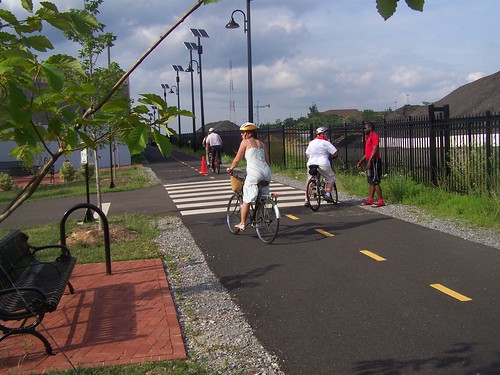A key problem in "community" planning: not simultaneously defining community-wide and neighborhood goals and objectives
In the District’s Ivy City, a Northeast neighborhood down on its luck for decades, the two dozen residents who came to Council member Harry Thomas Jr.’s community meeting had plenty to talk about.
They asked Thomas about efforts to redevelop an old school site, pressed him on why some special-education students are bused out of town, and noted that they prefer recreational centers in Ward 5 instead of bike lanes and dog parks.
Besides the fact that 25 people in one particular neighborhood doesn't necessarily adequately reflect all the neighborhoods in the ward and the opinions of the entire ward's residents of about 75,000 people, this does reflect a conundrum in planning generally, one that isn't handled that well in DC.
Planning has two sets of goals and objectives, one is general--for the entire community--and the other is more specific, to cover either or both areas/districts/sectors or even smaller areas called "neighborhoods."
In DC, we don't do sector/district plans, although there are 10 defined "area elements" within the Comprehensive Land Use Plan, nor do we do "neighborhood" or "community" plans. Thus far area elements are a grab bag of priorities.
We do what are called "small area plans," but they are not complete neighborhood plans.
The plans don't typically cover everything that ought to be in a comprehensive neighborhood plan, such as public facilities, open space and recreation, culture and historic preservation--mostly they deal with land use and transportation matters.
When we do community planning, in my experience, we don't simultaneously define "city-wide," "area," and "neighborhood" goals and objectives. So residents end up focusing on how they define their neighborhood, while planners try to deal with both citywide and neighborhood priorities.
Regardless of whether "Ward 5" residents "want" bike lanes, the reality is that the city should prioritize creating a complete bikeways network for the entire city. People outside of Ward 5 ride or walk on the Metropolitan Branch Trail, which is located in three wards--W4, W5, and W6.
It is insane that parochial concerns of W5 residents should be used to direct how citywide bikeway resources are expended within their ward, because it isn't just a ward-specific issue.
But I will say that the W5 meeting referenced by the Post isn't a planning meeting, it's a political/community meeting organized and conducted by the Ward 5 Councilmember, who likely doesn't try to model best practice civic assets planning when he does his meetings.
(I know that he really doesn't like it when people speak out at such meetings, meetings that he wants to be completely in control of...)
Labels: land use planning, neighborhood planning, transportation planning




0 Comments:
Post a Comment
<< Home